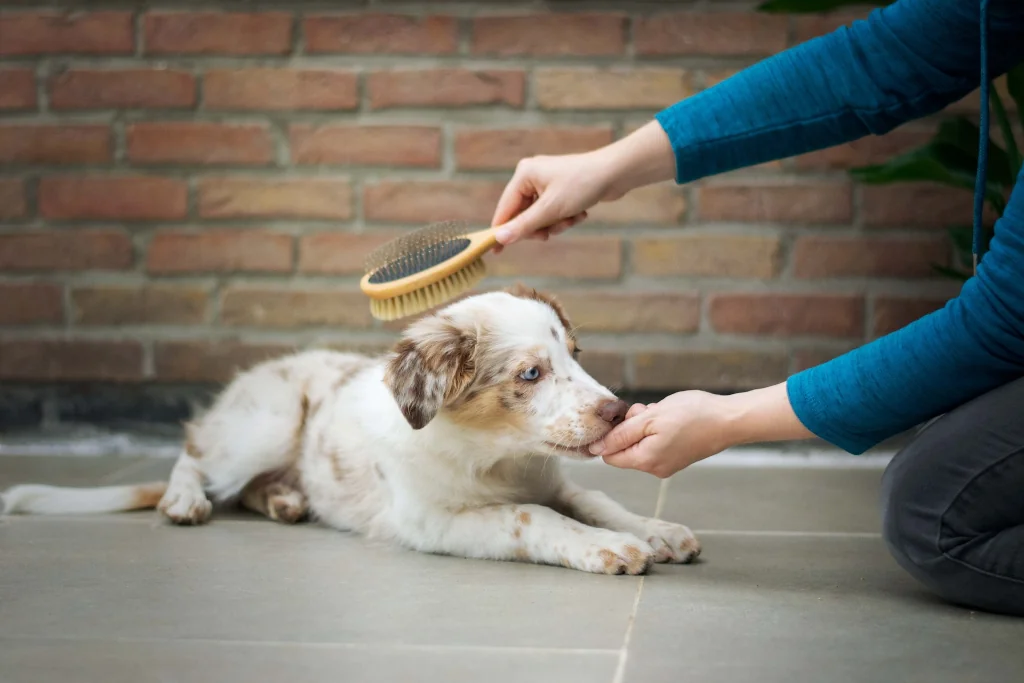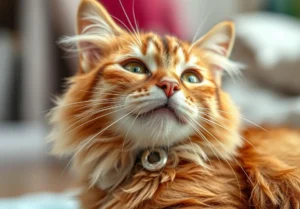Disclosure: We may earn a commission from helpful, relevant links in our content. No cost to you. See our privacy policy.
Dog hair, dog hair, everywhere.
From your favorite black sweater to your once-crisp white sheets, it feels like an endless fur festival.
And those pesky knots in Fido’s coat? You’ve practically considered a side gig as a doggy hairstylist. Let’s put an end to the endless shedding and matting. Ready to turn the tide on grooming?
Perfect, we’re here to help guide you through the brush strokes.

Why Is Regular Grooming Important for Your Dog?
Proper grooming is more than an aesthetic necessity for your four-legged friend.
Regular brushing promotes healthy skin, a vibrant coat, and provides a unique opportunity for bonding. Consider it a wellness routine for your pet – akin to a check-up, as it allows you to keep a watchful eye for any skin anomalies or unusual lumps.
So yes, grooming is just as important as those much-anticipated walks.
Types of Brushes and Combs: The Basics
Just like humans, dogs need the right tools for their hair type. Lucky for you, we’ve broken down the basics here:
Slicker Brushes
Slicker brushes, with their fine, short wires placed closely together, excel at detangling matted hair. Not just that, their dense bristles distribute natural oils throughout your dog’s coat, promoting a healthy shine.
A good slicker brush, such as the Hertzko Self-Cleaning Slicker Brush, comes with an easy-clean feature that saves you time post-grooming.
Bristle Brushes
Bristle brushes are the preferred choice for short-haired, smooth-coated dogs who shed frequently. These brushes catch loose fur effectively, leaving your dog’s coat looking smooth and shiny.
Our pick in this category is the Safari Bristle Brush, available in various sizes to suit your dog’s needs.
Pin Brushes
Pin brushes, akin to human hairbrushes, are tailored for long, silky-haired breeds. Their lengthy tines reach deep into the dog’s coat to detangle and remove loose fur without causing any discomfort.
A reliable choice for this type is the Andis Premium Large Pin Brush. It’s good quality for the price brush, not too expensive, and gets the job done.
Deshedding Tools
If you’re a pet parent of a heavy-shedding breed, a deshedding tool will become your best friend. They reach deep into your dog’s undercoat to remove loose hairs even before they hit your floor or furniture.
The FURminator Deshedding Tool is a standout product that can revolutionize your grooming routine.
Combs
No dog owner’s grooming kit is complete without a comb. They’re perfect for a final check after brushing, removing any remaining tangles, and serving as a tool to check for fleas.
The Andis Pet Steel Grooming Comb glides smoothly through hair and is a versatile addition to your toolkit. It cleans dense fur with ease, and makes the coat fluffy and knot-free.
Remember, the correct brush or comb can make grooming a breeze. A well-groomed dog is a happier, healthier pet. And fewer dog hair dust bunnies for you – sounds like a win-win, doesn’t it?
For a full guide, follow our post on how to choose the perfect dog brush.

Step-by-Step Guide to Brushing and Combing Your Dog
Prepare for Grooming
Before you even begin brushing, create a calm and quiet environment to help your dog feel at ease. Treats nearby can be a great incentive for your furry friend to behave during grooming.
Make sure you have the correct brush or comb based on your dog’s coat type (see section above).
Spot Check
Before you begin brushing, inspect your dog’s coat for any visible mats, tangles, fleas, or skin issues. You don’t want to blindly pull a brush through a painful knot or scrape over an irritated patch of skin.
Start From the Head
Start brushing your dog’s coat from their head and work your way towards the tail. This approach aligns with the direction of fur growth, making it more comfortable for your pet. Brush in long, gentle strokes.
Go Layer by Layer
For dogs with thick or double coats, you’ll want to brush layer by layer. You can do this by lifting a section of their fur and brushing the undercoat first, then moving onto the topcoat. This ensures you’re reaching all of the fur and not just the top layer.
Be Gentle with Knots
If you encounter a mat or tangle, don’t yank or pull it out with force. Use a detangling solution or mat splitter tool if necessary. If you’re unsure or if the mat is too large or close to the skin, seek help from a professional groomer.
End on a Positive Note
Once you’ve brushed your dog’s entire body, give them a treat, praise, or playtime. This helps create positive associations with grooming and makes it easier for future sessions.
This process might seem a bit meticulous at first, but it’ll become more straightforward with practice. Your dog’s coat will thank you for it – and let’s not forget about those reduced hair tumbleweeds around the house!
Suggested reading: Dog Bathing and Nail Trimming guides
How Often Should You Groom Your Dog?
The frequency of grooming depends on your dog’s breed, coat type, and lifestyle.
Dogs with long, curly, or thick coats typically require daily brushing to prevent matting and tangling. Short-haired breeds may only need a good brush-down once a week.
Keep an eye on your dog’s coat – if it starts to look dull, or if you’re finding more hair around the house, it may be time for a brushing session.
Making Grooming a Pleasant Experience for Your Dog
To make grooming enjoyable, use positive reinforcement like treats and praise.
Depending on how behaved your dog is during a grooming session, you can choose between low-value treats for regular motivation, and high-value treats as special prizes. These are used for training, but they will work for grooming, too.
Always be gentle and patient, especially when dealing with mats or tangles. Create a calm environment and keep grooming sessions short to begin with, gradually increasing the time as your dog gets comfortable.
Pro tip
Playing soft, soothing music during grooming sessions can help to create a relaxing environment for your dog. A calm dog is much easier to groom, and over time, they may even start to look forward to these sessions.
Suggested reading: Dog Care – Your Dog’s Ear Cleaning Guide
As a pet owner, I understand the challenges that grooming can present. But believe me when I say, perseverance pays off. As you and your dog work through these steps together, you’ll find your rhythm.
The initial fuss will subside, replaced by a relaxed routine that both you and your pet grow to appreciate. Grooming then stops being a chore, transforming into an opportunity for bonding.
And remember, you’re not just brushing their coat – you’re also paving the way for their long-term health and well-being.
Looking for other dog grooming guides? Check out dog bathing and nail trimming.
FAQs
Can I use human brushes or combs for my dog?
Human brushes and combs may not effectively detangle and clean dog’s fur and can potentially damage their coat. Always use grooming tools specifically made for dogs.
What should I do if my dog doesn’t like being brushed or combed?
Start with gentle brushing in areas they’re comfortable with, and expand over time. If your dog resists brushing, try creating positive associations with treats and praise, which means rewarding them when they behave.
Does my dog’s diet affect the condition of its coat?
Yes, a dog’s diet plays a significant role in the health of their coat. Quality dog food, rich in essential fatty acids, contributes to a healthy coat.
How can I help my puppy get used to grooming?
To get a puppy accustomed to grooming, start early with gentle, short sessions. Pair grooming with positive reinforcement to make it a favorable experience.
Alex, a passionate animal lover, has experience in training and understanding animal behavior. As a proud pet parent to two dogs and three cats, he founded AnimalReport.net to share insights from animal experts and expand his knowledge of the animal kingdom.





Thank you a lot for sharung this with all of uus you actually understand what you aare talking
about! Bookmarked. Please also consult with my web site =).
We will have a link exchange agreement between us